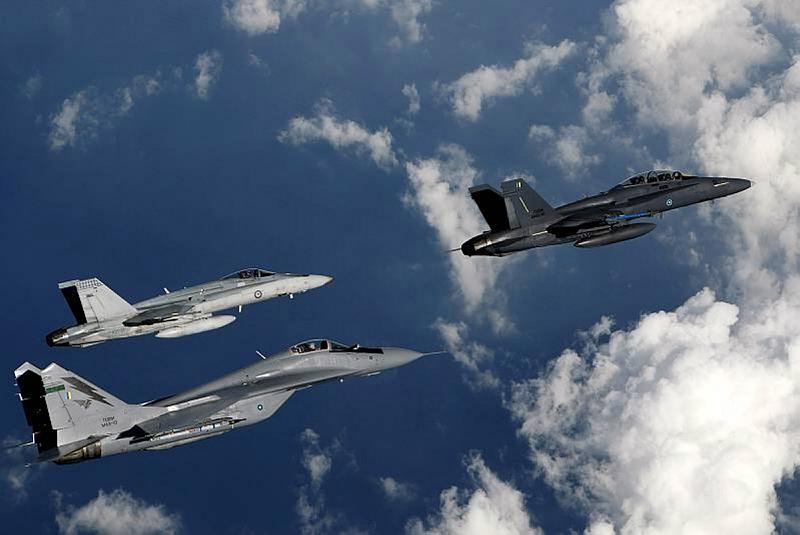Malaysian–Australian relations: close to the limit (part II)
Posted By Dzirhan Mahadzir on September 3, 2012 @ 14:59
 [1]In my last post [2], I outlined the development of the long-standing defence relationship between Australia and Malaysia. While there is strong history between both militaries, the difference in the ways in which they are utilised accounts for, in part, the limit to how close a defence relationship there can be. Here, I examine additional factors impacting on Australia–Malaysia cooperation.
[1]In my last post [2], I outlined the development of the long-standing defence relationship between Australia and Malaysia. While there is strong history between both militaries, the difference in the ways in which they are utilised accounts for, in part, the limit to how close a defence relationship there can be. Here, I examine additional factors impacting on Australia–Malaysia cooperation.
First is the issue of defence budgets; both countries are facing the issues of limited budgets for their militaries which in turn affects their capability for future training, particularly when having to deploy assets out of country. Indeed the RMAF’s non-participation at this year’s RAAF Pitch Black exercise in Australia was due to a lack of funding. It might be expected that both militaries may have to curtail some of their activities in the future in order to accommodate the budget.
Second, further expansion of training and cooperation may largely be moot due to the existing commitments of both nations. All three services of the ADF are heavily involved with Australia’s global missions and, with the presence of the US military in Darwin, the ADF will add additional joint exercise and training activities to its schedule and thus be limited in what it can provide in regard to other bilateral military cooperation and training. In Malaysia, the Royal Malaysian Navy and RMAF face the problem that their forces are undersized for patrolling Malaysia’s extensive maritime waters and airspace and as such are heavily committed, which limits the assets and personnel available for cooperation and training with foreign forces. The Malaysian Army, given its size, could easily accommodate an increased scope of military exercises with its Australian Army counterparts in the form of company- or battalion-sized mechanised, armour or artillery exercises. But the fact that both countries have sufficient training areas for such in their respective countries means that neither army can justify the costs of shipping heavy equipment and troops overseas for an exercise, particularly in an era of budgetary restraint.
Finally, the fact remains that Malaysia is still finding its feet in developing both a national security policy and a policy in relation to the armed forces and its use in a regional and global security context. Fundamentally, the root of the problem lies in the Mahathir era; not only was decision and policymaking highly centralised around then Prime Minister Tun Mahathir, he was at the helm for far too long. I don’t think that Mahathir ever really understood the role, context and use of a nation’s military. At the same time, he failed to develop the concept, principles and ideals of national security for Malaysia in relation to the global environment—though I might wryly add that he overdeveloped national security in the domestic context. Mahathir’s successor, Tun Abdullah Badawi failed to remedy the shortcomings he inherited.
Part of the blame should also fall upon the Malaysian National Security Division: while Mahathir’s autocratic nature may have stifled the NSD in developing a clear national security strategy, there is no excuse for the NSD to have failed to initiate efforts to address this issue in the more open administrations of Badawi or current Prime Minister Dato’ Seri Najib Tun Razak. While Najib Tun Razak has more experience in the defence and security field from his two tenures as Defence Minister, at the moment he is preoccupied with domestic politics.The need for him to prepare for a general election which must be held by 2013 coupled with the intense political battles (or one should more aptly say, nonsense) that has been going on in Malaysia between the ruling coalition and political opposition for the past four years has led to little focus by Najib on articulating how the Malaysian military should be employed in a regional or global security context. In absence of clear policy guidance, it is difficult to see how best to foster further military cooperation which dovetails with Malaysia’s national security outlook or goals in regard to the regional and global environment.
For all of those reasons, Malaysia–Australia defence cooperation efforts might now have reached their limits.
Dzirhan Mahadzir is a defence journalist, Malaysia correspondent for Janes Defence Weekly and former guest lecturer on military history and strategy, Malaysian Armed Forces Defence College. Image courtesy of Department of Defence [3].
Article printed from The Strategist: https://aspistrategist.ru
URL to article: /malaysian-australian-relations-close-to-the-limit-part-ii/
URLs in this post:
[1] Image: https://aspistrategist.ru/wp-content/uploads/2012/09/20111012raaf8540620_0148.jpg
[2] last post: https://aspistrategist.ru/malaysian-australian-relations-close-to-the-limit-part-i/
[3] Department of Defence: http://images.defence.gov.au/20111012raaf8540620_0148.jpg
Click here to print.